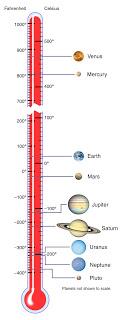A nice bit of sleight of hand by NASA Science:
This graphic shows the average temperatures of various destinations in our solar system. (Planets not to scale):

In general, the surface temperatures decreases with increasing distance from the sun.
Venus is an exception because its dense atmosphere acts as a greenhouse and heats the surface to above the melting point of lead, about 880 degrees Fahrenheit (471 degrees Celsius). Mercury rotates slowly and has a thin atmosphere, and consequently, the night-side temperature can be more than 1,000 degrees Fahrenheit lower than the day-side temperature shown on the diagram. It can be as cold as -290 degrees Fahrenheit (-179 degrees Celsius) on Mercury at night.
Their explanation why Venus is the exception is completely wrong, which they admit in the footnote:
Temperatures for the gas and ice giants (Jupiter, Saturn, Uranus, and Neptune) are taken from a level in the atmosphere equal in pressure to sea level on Earth.
The average temperature given for Earth is also at sea-level pressure, so there are two outliers. There is practically no atmosphere on Mercury (it could be correspondingly hotter if it had one), and Venus' surface has atmospheric pressure 90 times that of earth.
And what is the average temperature of Venus' atmosphere fairly high up, where pressure is equal to sea level pressure on Earth..?
About 70C of course, which is exactly what you'd expect if you extrapolate from the others. They also don't make it explicit that the composition of the atmospheres of all these planets are wildly different, which means that it is pretty irrelevant which gases are in them, CO2 (like Venus), N (like Earth), O2, H2O vapour, whatever.
